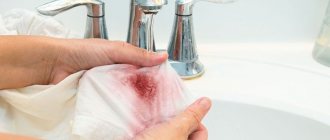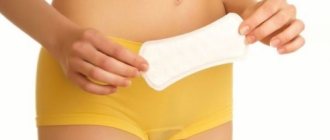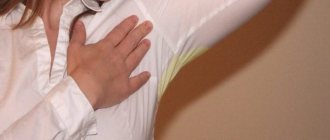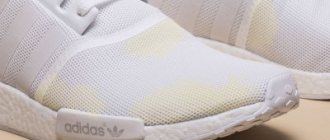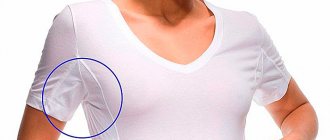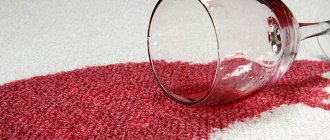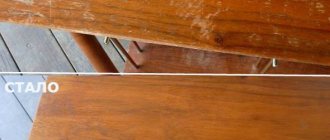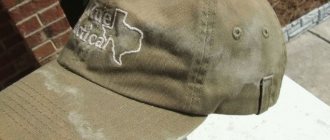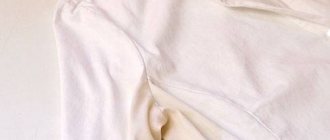Folk remedies
You can get rid of fresh stains using improvised means. But traditional methods often act unpredictably, so we advise you to first test them on an inconspicuous area of tissue. With expensive delicate fabrics, it is better not to take risks and entrust the item to a trusted dry cleaner or buy a special stain remover.
Vinegar
Vinegar dissolves traces of sweat and removes odors well. Mode of application:
- soak the yellow stain with 9% vinegar;
- leave for an hour;
- rinse the item well under running water;
- wash as usual.
If you need to clean silk or finicky synthetics, the bite needs to be diluted. Take 1 tsp. acid, about a glass of water, apply the mixture to the cloth and leave for 10 minutes. Then rinse well and wash as usual.
Laundry soap
Suitable for fresh stains or as an addition to other recipes:
- moisten the stains with plain water;
- wash the item with laundry soap;
- After 10–20 minutes, wash the item completely.
Hydrogen peroxide
Peroxide removes odors and yellowness. This is a gentle bleach for light-colored fabrics with any composition.
Place a couple of drops of peroxide on the stains until the material is completely saturated. Wait half an hour and wash the item. If this does not help, soak the product:
- add 1 bottle of peroxide to 1.5 liters of water;
- immerse clothes in the solution for 30 minutes;
- wash as usual.
Soda and salt
They can be mixed or used separately.
How to use baking soda:
- mix with water until pasty;
- distribute evenly over stains;
- After complete drying, brush off the powder with a soft brush.
How to use salt:
- moisten dirty places with water and sprinkle thickly with salt;
- leave overnight;
- Use a soft brush to remove dried salt.
To remove large stains, take salt and soda in equal proportions, mix with a small amount of laundry soap shavings, apply to the stains and leave to dry. Then wash with washing powder.
Ammonia and aspirin
To restore freshness to white items:
- mix 1 tsp. ammonia and half a glass of water;
- moisten the stain with the solution;
- grind a pack of aspirin into powder and add a little water;
- rub the pulp into the areas treated with ammonia;
- leave until completely dry and wash the item.
Lemon juice
A method for cleaning white things. Freshly squeezed juice and a lemon from the seasoning department will do:
- prepare lemon juice or dilute a teaspoon of acid in a glass of water;
- Apply the product to the stains;
- After 15 minutes, rinse the product and wash with powder.
Dishwashing liquid
Dish gels contain glycerin, which dissolves organic stains. You can buy it at the pharmacy, but you should choose a clear liquid without dye. Mode of application:
- apply glycerin to the stains;
- leave for a couple of hours;
- Wash your clothes as usual: in a machine or by hand.
Recommendations
In order not to spoil an expensive wardrobe item, you should adhere to the following rules:
- Do not use chlorine bleach on fabrics of any color. Due to chlorine reacting with proteins contained in human sweat, fabric fibers may darken. This will make the stain even more noticeable.
- It is not recommended to wash sweat-contaminated items in too hot water or dry them at high temperatures. The aggressive method of boiling laundry is used only with items made of durable fabrics. The fact is that hot water can not only deform the fabric, but also often helps to fix contaminants, and heated air enhances the unpleasant odor that products such as ammonia and others can leave on things. It is recommended to wash items at a gentle temperature of 30 ºC and dry them in the bathroom or in the fresh air.
- Silk products cannot be treated with acetic acid or acetone. Many stain removers are also not recommended for cleaning silk fabrics. Synthetics “do not like” gasoline and substances based on it. Cotton fabrics do not tolerate acids well, and wool does not tolerate alkaline solutions.
- It is highly recommended not to use acetone for colored clothing. It may discolor the fabric.
The best gifts you need:
|
Special means
Professional products do a better job of removing stains. Universal stain removers are suitable for removing fresh stains, and special ones for cleaning dried stains:
- Vanish "Crystal White".
This is a universal bleach that can handle light-colored fabrics. Add 50 ml of Vanish to 2 liters of water and soak the item for an hour. Then machine wash. To enhance the effect, you can add 100 ml of the product to the powder compartment and select the appropriate washing mode. Pre-treat stains with a product. - Stain remover FINCLEAN Professional.
A universal oxygen cleaner with a gentle, odorless composition. Pour the powder into a bowl of warm water and soak your clothes overnight. Wash and rinse well in the morning. - HG to remove traces of sweat and deodorant from things.
The spray is designed to pre-treat stains before washing. Can be used not only for white, but also for colored fabrics. Creates an invisible film on the fabric, therefore preventing the appearance of yellow marks. - Spray stain remover Dr.
Beckmann "Deodorant and sweat." Suitable for stubborn stains. Apply the spray to the stains and leave for 10 minutes, then wash the item. The product can be used for all types of fabrics.
Why do white spots appear on clothes?
White spots of a blurred shape appear on clothes during profuse sweating. The main function of sweating is thermoregulation. At low temperatures, when it is cold, the removal of fluid slows down significantly. Against the backdrop of hot weather conditions, on the contrary, it increases significantly. Sweat prevents the skin from overheating and burning. White deposits on clothes are salts that have settled in the tissues after the evaporation of liquids.
On average, an adult produces up to 500 ml of sweat every day. During hot times of the day, during illness, as well as in people with excessive sweating, the amount of sweat produced can be significantly higher.
Sweat has the following composition (main elements):
- lactic/uric acid;
- sulfuric acid;
- phosphates;
- calcium salts;
- urea;
- ammonia;
- amino acids;
- fatty acid.
Sweat glands are located throughout the body, but their main location is the groin area and armpits. Often white spots on clothes appear in the lower back, on the collar, and in the chest area.
It is worth noting that white stains from sweat can become so ingrained that they can only be removed with professional chemicals (for example, “Vanish”). In simple cases, improvised means, for example, laundry soap or baking soda, may be suitable.
Fresh stains are best washed. If the fabric is hypersensitive to certain types of mineral compounds, the salt can “eat away” the color and a stain will form on the clothing that cannot be removed.
Removing difficult stains
Method 1. Vodka or alcohol.
You can simply soak the stains with vodka, and 96% alcohol should be mixed with water in a 1:2 ratio. Pour the solution over the dirt and wash it well after drying.
Method 2. White spirit or household gasoline.
This is the most radical remedy that can be used if other methods do not help:
- moisten contaminated areas with the substance;
- after 10 minutes, rinse the item under the tap;
- wash as usual.
White for floor cleaning and home disinfection
It can be used as a home and floor disinfectant, but before doing so, you must carefully review the precautions:
- Bleach is a substance that can leave burns on the body, because the composition of the bleach is quite aggressive. Therefore, before using this product, you must wear household gloves, put a mask (respirator) on your face, and after disinfection, you must thoroughly ventilate the room.
- It should be stored in a dark and cool place, away from animals and children. Bleach is stored for 1 year, after this time the product must be thrown away.
- It is prohibited to use sodium hypochlorite for self-treatment; this can cause great harm to a person and his health.
Prevention
It is easier to prevent stains from appearing than to remove yellow stains. Use these recommendations:
- use preventive sprays that create a protective film on the fabric;
- use special pads for the armpits;
- choose antiperspirants that leave no residue;
- wear loose clothing that is not too tight to the body;
- wash white items immediately after wearing them;
- Blot sweat periodically with dry wipes.
Treatment methods
Treatment methods for chromohidrosis largely depend on the causes of its occurrence:
- When the release of colored sweat is associated with health problems, the emphasis is on eliminating the main pathology, and then, if necessary, auxiliary methods are followed.
- If the cause of the condition is exposure to harmful industrial or environmental factors, there is reason to think about changing your job or place of residence.
In some cases, to eliminate hyperhidrosis, and at the same time the problem of colored sweat, doctors offer radical methods:
- ultrasonic destruction of sweat glands;
- removing them by liposuction or endoscopic curettage;
- surgical excision of an area of excessive sweating, removal of a fragment of skin with sweat glands located on it.
Radical methods can cause complications such as compensatory hyperhidrosis, that is, the formation of new areas of excess sweating. In such cases, a course of acupuncture is indicated.
Recently, Botox injections have been used as a new method in the fight against hyperhidrosis. They are guaranteed to relieve the problem of excessive sweating, although not for long. Eight to ten months later the procedure will have to be repeated.
The appearance of yellow sweat under the arms
Yellow sweat under the arms may indicate problems with the liver or may occur against the background of the favorable development of pathogenic microorganisms. Moreover, this pathology is not life-threatening (the exception is cases when, in combination with colored sweat, a pungent odor of urine appears).
The occurrence of yellow sweat due to increased levels of bilirubin in the blood requires a full examination and the appointment of the correct treatment to eliminate the resulting pathology. If a manifestation of this phenomenon is noted, then the intensity of the color is not an accurate method for diagnosing a possible disease.
Pharmacists have not developed an accurate and effective remedy to combat the manifestation of yellow sweat, since the activity of the apocrine glands has not been well studied. As an alternative, you can use special antiperspirants, but with long-term use they have serious side effects.
The appearance of yellow sweat under the arms does not have a direct effect on the development of additional diseases in the body, but can provoke the gradual development of pathologies in the body:
- Exacerbation of gastritis and subsequent formation of stomach ulcers;
- Development of insomnia, nervous condition;
- Headaches and other disorders in the body.
In order to eliminate the manifestations of yellow sweat as much as possible, it is best to find out the exact cause of the phenomenon and obtain the most suitable treatment regimen.
Colored sweat discharge - diagnosis
Having discovered that during the day the underwear in the places where the secretion comes out becomes stained, a person turns to a specialist. Often, underwear is stained in the armpit area. First you need to find out why yellow sweat is released from the body.
In order to obtain an accurate diagnosis, it is necessary:
- identify past diseases;
- conduct research on fungi and microflora;
- study blood and urine tests.
Depending on the case, the doctor will inform you about the need to conduct drinking water tests.
Diet for hyperhidrosis
When following a diet to eliminate excessive sweating, it is necessary to exclude the following foods from the general diet:
- Ketchup, various sauces;
- Products containing caffeine and theobromine (tea, coffee, Coca-Cola);
- Hot spices and herbs (coriander, pepper, ginger, salt);
- Legumes (peas, beans, asparagus);
- Psychostimulants that are included in alcoholic beverages;
- Fatty meats (pork, lamb);
- Onion garlic;
- Carbonated drinks.
This category of products helps to increase nervous excitability of the central nervous system and increases the intensity of sweating.
Proper nutrition should be used on the following products:
- Cereal porridge;
- Fruits and vegetables in moderation (figs, carrots, lettuce, kohlrabi cabbage);
- Vegetable broths;
- Compotes from fresh berries and dried fruits;
- Lean varieties of meat and fish (veal, chicken, rabbit, hake, cod).
False or true chromohidrosis?
Chromohidrosis can be true or false. True chromohidrosis is caused by a genetic predisposition. Coloring of the liquid occurs due to a violation in the structure of the glands. Also, the problem often plagues residents of areas with poor ecology. The discharge in this case of false chromohidrosis is colorless. Color only after contact with skin.
In true chromohidrosis, the cause of the yellow discharge may be a problem with the kidneys. Then the accumulated urea finds its way out through the skin.
The false type of disease is also caused by bacteria that live on the hair follicles. Their waste products can stain sweat.
Neglect of personal hygiene rules can also cause hyperhidrosis, which in turn will turn into chromohidrosis over a period of time.
